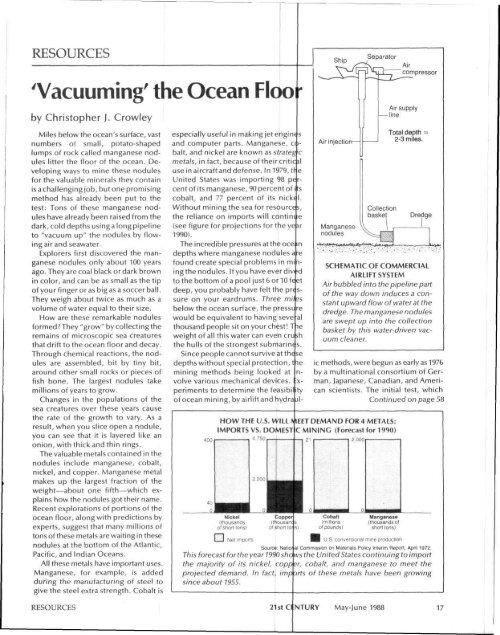The Geometry The Nucleus
The Geometry The Nucleus
The Geometry The Nucleus
Create successful ePaper yourself
Turn your PDF publications into a flip-book with our unique Google optimized e-Paper software.
'Vacuuming' the Ocean Floo<br />
by Christopher J. Crowley<br />
Miles below the ocean's surface, vast<br />
numbers of small, potato-shaped<br />
lumps of rock called manganese nodules<br />
litter the floor of the ocean. Developing<br />
ways to mine these nodules<br />
for the valuable minerals they contain<br />
is a challenging job, but one promising<br />
method has already been put to the<br />
test: Tons of these manganese nodules<br />
have already been raised from the<br />
dark, cold depths using a long pipeline<br />
to "vacuum up" the nodules by flowing<br />
air and seawater.<br />
Explorers first discovered the manganese<br />
nodules only about 100 years<br />
ago. <strong>The</strong>y are coal black or dark brown<br />
in color, and can be as small as the tip<br />
of your finger or as big as a soccer ball.<br />
<strong>The</strong>y weigh about twice as much as a<br />
volume of water equal to their size.<br />
How are these remarkable nodules<br />
formed? <strong>The</strong>y "grow" by collecting the<br />
remains of microscopic sea creatures<br />
that drift to the ocean floor and decay.<br />
Through chemical reactions, the nodules<br />
are assembled, bit by tiny bit,<br />
around other small rocks or pieces of<br />
fish bone. <strong>The</strong> largest nodules take<br />
millions of years to grow.<br />
Changes in the populations of the<br />
sea creatures over these years cause<br />
the rate of the growth to vary. As a<br />
result, when you slice open a nodule,<br />
you can see that it is layered like an<br />
onion, with thick and thin rings.<br />
<strong>The</strong> valuable metals contained in the<br />
nodules include manganese, cobalt,<br />
nickel, and copper. Manganese metal<br />
makes up the largest fraction of the<br />
weight—about one fifth—which explains<br />
how the nodules got their name.<br />
Recent explorations of portions of the<br />
ocean floor, along with predictions by<br />
experts, suggest that many millions of<br />
tons of these metals are waiting in these<br />
nodules at the bottom of the Atlantic,<br />
Pacific, and Indian Oceans.<br />
All these metals have important uses.<br />
Manganese, for example, is added<br />
during the manufacturing of steel to<br />
give the steel extra strength. Cobalt is<br />
RESOURCES<br />
especially useful in making jet engine s<br />
and computer parts. Manganese, cobalt,<br />
and nickel are known as strateg c<br />
metals, in fact, because of their critic il<br />
use in aircraft and defense. In 1979, tr e<br />
United States was importing 98 percent<br />
of its manganese, 90 percent of i :s<br />
cobalt, and 77 percent of its nick* I.<br />
Without mining the sea for resource 5,<br />
the reliance on imports will contini e<br />
(see figure for projections for the ye ir<br />
1990).<br />
<strong>The</strong> incredible pressures at the oce in<br />
depths where manganese nodules a 'e<br />
found create special problems in mi v<br />
ingthe nodules. If you have ever div id<br />
to the bottom of a pool just 6 or 10 feet<br />
deep, you probably have felt the pre s-<br />
sure on your eardrums. Three mil=s<br />
below the ocean surface, the presst re<br />
would be equivalent to having seve al<br />
thousand people sit on your chest! T ie<br />
weight of all this water can even cru sh<br />
the hulls of the strongest submarine s.<br />
Since people cannot survive at the se<br />
depths without special protection, t ie<br />
mining methods being looked at n-<br />
volve various mechanical devices. :xperiments<br />
to determine the feasibil ity<br />
of ocean mining, by airlift and hydra jl-<br />
SCHEMATIC OF COMMERCIAL<br />
AIRLIFT SYSTEM<br />
Air bubbled into the pipeline part<br />
of the way down induces a constant<br />
upward flow of water at the<br />
dredge. <strong>The</strong> manganese nodules<br />
are swept up into the collection<br />
basket by this water-driven vacuum<br />
cleaner.<br />
ic methods, were begun as early as 1976<br />
by a multinational consortium of German,<br />
Japanese, Canadian, and American<br />
scientists. <strong>The</strong> initial test, which<br />
Continued on page 58<br />
HOW THE U.S. WILL NIEET DEMAND FOR 4 METALS:<br />
IMPORTS VS. DOMESTC MINING (Forecast for 1990)<br />
U.S. conventional mine production<br />
Source: Natiorjal Commission on Materials Policy Interim Report, April 1972.<br />
This forecast for the year 1990 sho ws the United States continuing to import<br />
the majority of its nickel, copper, cobalt, and manganese to meet the<br />
projected demand. In fact, imports of these metals have been growing<br />
since about 7955.<br />
21st CI NTURY May-June 1988 17

















